Enhancing Gas Permeation Properties of Pebax® 1657 Membranes via Polysorbate Nonionic Surfactants Doping
Abstract
1. Introduction
2. Experimental Section
2.1. Materials
2.2. Methods
2.2.1. Membrane Preparation
2.2.2. Membrane Characterization
2.2.3. Gas Permeation Tests
3. Results and Discussion
3.1. Solution Stability
3.2. Membrane Morphology
3.3. Membrane Spectroscopic Properties
3.4. Membrane Mechanical Properties
3.5. Membrane Gas Transport
3.6. Temperature Effect
4. Conclusions
Author Contributions
Funding
Acknowledgments
Conflicts of Interest
References
- Bernardo, P.; Drioli, E.; Golemme, G. Membrane gas separation: A review/state of the art. Ind. Eng. Chem. Res. 2009, 48, 4638–4663. [Google Scholar] [CrossRef]
- Lin, H.; Freeman, B.D. Gas and Vapor Solubility in Cross-Linked Poly(ethylene Glycol Diacrylate). Macromolecules 2005, 38, 8394–8407. [Google Scholar] [CrossRef]
- Lin, H.; Freeman, B.D. Membrane Materials to Remove CO2 from Gas Mixtures. J. Mol. Struct. 2005, 739, 57–74. [Google Scholar] [CrossRef]
- McKeen, L.W. 10—Thermoplastic Elastomers. In McKeen, Fatigue and Tribological Properties of Plastics and Elastomers, 3rd ed.; William Andrew Publishing: Oxford, UK, 2016; pp. 279–289. [Google Scholar]
- Louie, J.S.; Pinnau, I.; Ciobanu, I.; Ishida, K.P.; Ng, A.; Reinhard, M. Effects of polyether-polyamide block copolymer coating on performance and fouling of reverse osmosis membranes. J. Membr. Sci. 2006, 280, 762–770. [Google Scholar] [CrossRef]
- Car, A.; Stropnik, C.; Yave, W.; Peinemann, K.-V. PEG modified poly(amide-b-ethylene oxide) membranes for CO2 separation. J. Membr. Sci. 2008, 307, 88–95. [Google Scholar] [CrossRef]
- Marcq, J.; Quang, T.N.; Langevin, D.; Brule, B. Abatement of CO2 emissions by means of membranes—Characterization of industrial Pebax™ films. Environ. Prot. Eng. 2005, 31, 13–22. [Google Scholar]
- Yave, W.; Car, A.; Peinemann, K.-V. Nanostructured membrane material designed for carbon dioxide separation. J. Membr. Sci. 2010, 350, 124–129. [Google Scholar] [CrossRef]
- Yave, W.; Car, A.; Funari, S.S.; Nunes, S.P.; Peinemann, K.-V. CO2-Philic polymer membrane with extremely high separation performance. Macromolecules 2010, 43, 326–333. [Google Scholar] [CrossRef]
- Peinemann, K.-V.; Johannsen, G.; Yave, W.; Car, A. Polymer Membrane. U.S. Patent 20110120304 A1, 25 June 2008. [Google Scholar]
- Yave, W.; Car, A. Polymeric membranes for post-combustion carbon dioxide (CO2) capture. In Advanced Membrane Science and Technology for Sustainable Energy and Environmental Applications; Basile, A., Pereira Nunes, S., Eds.; Woodhead Publishing: Cambridge, UK, 2011; Chapter 6; pp. 160–193. [Google Scholar]
- Dong, L.-L.; Zhang, C.-F.; Zhang, Y.-Y.; Bai, Y.-X.; Gu, J.; Sun, Y.-P.; Chen, M.-Q. Improving CO2/N2 separation performance using nonionic surfactant Tween containing polymeric gel membranes. RSC Adv. 2015, 5, 4947–4957. [Google Scholar] [CrossRef]
- Clarizia, G.; Bernardo, P.; Gorrasi, G.; Zampino, D.; Carroccio, S.C. Influence of the preparation method and photo-oxidation treatment on the thermal and gas transport properties of dense films based on a poly(ether-block-amide) copolymer. Materials 2018, 11, 1326. [Google Scholar] [CrossRef]
- Wahab, M.S.A.; Sunarti, A.R. Development of PEBAX Based Membrane for Gas Separation: A Review. Int. J. Membr. Sci. Technol. 2015, 2, 78–84. [Google Scholar]
- Jiang, B.; Wang, B.; Zhang, L.; Sun, Y.; Xiao, X.; Yang, N.; Dou, H. Effect of Tween 80 on morphology and performance of poly(L-lactic acid) ultrafiltration membranes. J. Appl. Polym. Sci. 2017, 134, 44428–44436. [Google Scholar] [CrossRef]
- Milliman, H.W.; Boris, D.; Schiraldi, D.A. Experimental Determination of Hansen Solubility Parameters for Select POSS and Polymer Compounds as a Guide to POSS–Polymer Interaction Potentials. Macromolecules 2012, 45, 1931–1936. [Google Scholar] [CrossRef]
- Crowley, M.M.; Fredersdorf, A.; Schroeder, B.; Kucera, S.; Prodduturi, S.; Repka, M.A.; McGinity, J.W. The influence of guaifenesin and ketoprofen on the properties of hot-melt extruded polyethylene oxide films. Eur. J. Pharm. Sci. 2004, 22, 409–418. [Google Scholar] [CrossRef]
- Zhang, C.; Dong, L.; Zhang, Y.; Bai, Y.; Gu, J.; Sun, Y.; Chen, M. Poly(ether-b-amide)/Tween20 Gel Membranes for CO2/N2 Separation. Sep. Sci. Technol. 2015, 50, 2375–2383. [Google Scholar]
- Adamskaa, K.; Bellinghausen, R.; Voelkel, A. New procedure for the determination of Hansen solubility parameters by means of inverse gas chromatography. J. Chromatogr. A 2008, 1195, 146–149. [Google Scholar] [CrossRef]
- Isanejad, M.; Azizi, N.; Mohammadi, T. Pebax membrane for CO2/CH4 separation: Effects of various solvents on morphology and performance. J. Appl. Polym. Sci. 2017, 134, 44531–44539. [Google Scholar] [CrossRef]
- Mahdi, E.S.; Sakeena, M.H.F.; Abdulkarim, M.F.; Abdullah, G.Z.; Sattar, M.A.; Noor, A.M. Effect of surfactant and surfactant blends on pseudoternary phase diagram behavior of newly synthesized palm kernel oil esters. Drug Des. Dev. Ther. 2011, 5, 311–323. [Google Scholar] [CrossRef]
- Feng, S.; Ren, J.; Li, Z.; Li, H.; Hua, K.; Li, X.; Deng, M. Poly(amide-12-b-ethylene oxide)/glycerol triacetate blend membranes for CO2 separation. Int. J. Greenh. Gas Control 2013, 19, 41–48. [Google Scholar] [CrossRef]
- Sharma, P.; Kim, Y.-J.; Kim, M.-Z.; Alam, S.F.; Cho, C.H. A stable polymeric chain configuration producing high performance PEBAX-1657 membranes for CO2 separation. Nanoscale Adv. 2019, 1, 2633–2644. [Google Scholar] [CrossRef]
- Su, N.C.; Sun, D.T.; Beavers, C.M.; Britt, D.K.; Queen, W.L.; Urban, J.J. Enhanced permeation arising from dual transport pathways in hybrid polymer–MOF membranes. Energy Environ. Sci. 2016, 9, 922–931. [Google Scholar] [CrossRef]
- Johnston, I.D.; McCluskey, D.K.; Tan, C.K.L.; Tracey, M.C. Mechanical characterization of bulk Sylgard 184 for microfluidics and microengineering. J. Micromech. Microeng. 2014, 24, 035017. [Google Scholar] [CrossRef]
- Lau, C.H.; Li, P.; Li, F.; Chung, T.-S.; Paul, D.R. Reverse-selective polymeric membranes for gas separations. Prog. Polym. Sci. 2013, 38, 740–766. [Google Scholar] [CrossRef]
- Koros, W.J.; Mahajan, R. Pushing the limits on possibilities for large scale gas separation: Which strategies? J. Membr. Sci. 2000, 175, 181–196. [Google Scholar] [CrossRef]
- Robeson, L.M. The upper bound revisited. J. Membr. Sci. 2008, 320, 390–400. [Google Scholar] [CrossRef]
- Teplyakov, V.; Meares, P. Correlation aspects of the selective gas permeabilities of polymeric materials and membranes. Gas Sep. Purif. 1990, 4, 66–74. [Google Scholar] [CrossRef]
- Freeman, B.D.; Pinnau, I. Polymeric Materials for Gas Separations. ACS Symp. Ser. 1999, 733, 1–27. [Google Scholar]
- Matteucci, S.; Yampolskii, Y.; Freeman, B.D.; Pinnau, I. Transport of Gases and Vapors in Glassy and Rubbery Polymers. In Materials Science of Membranes for Gas and Vapor Separation; Yampolskii, Y., Pinnau, I., Freeman, B., Eds.; John Wiley & Sons, Ltd.: Chichester, UK, 2006; pp. 1–47. ISBN 13-978-0470853450. [Google Scholar]
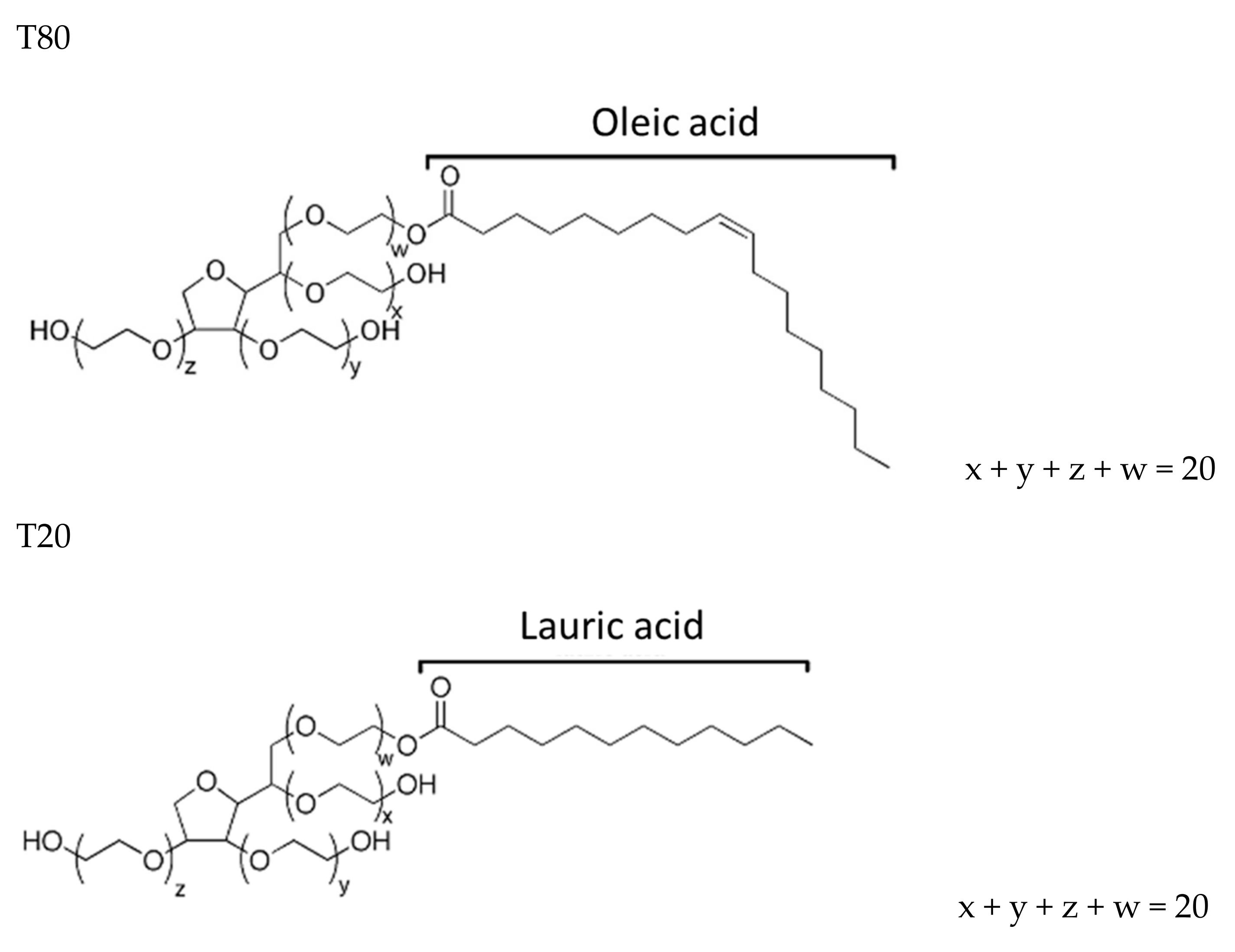
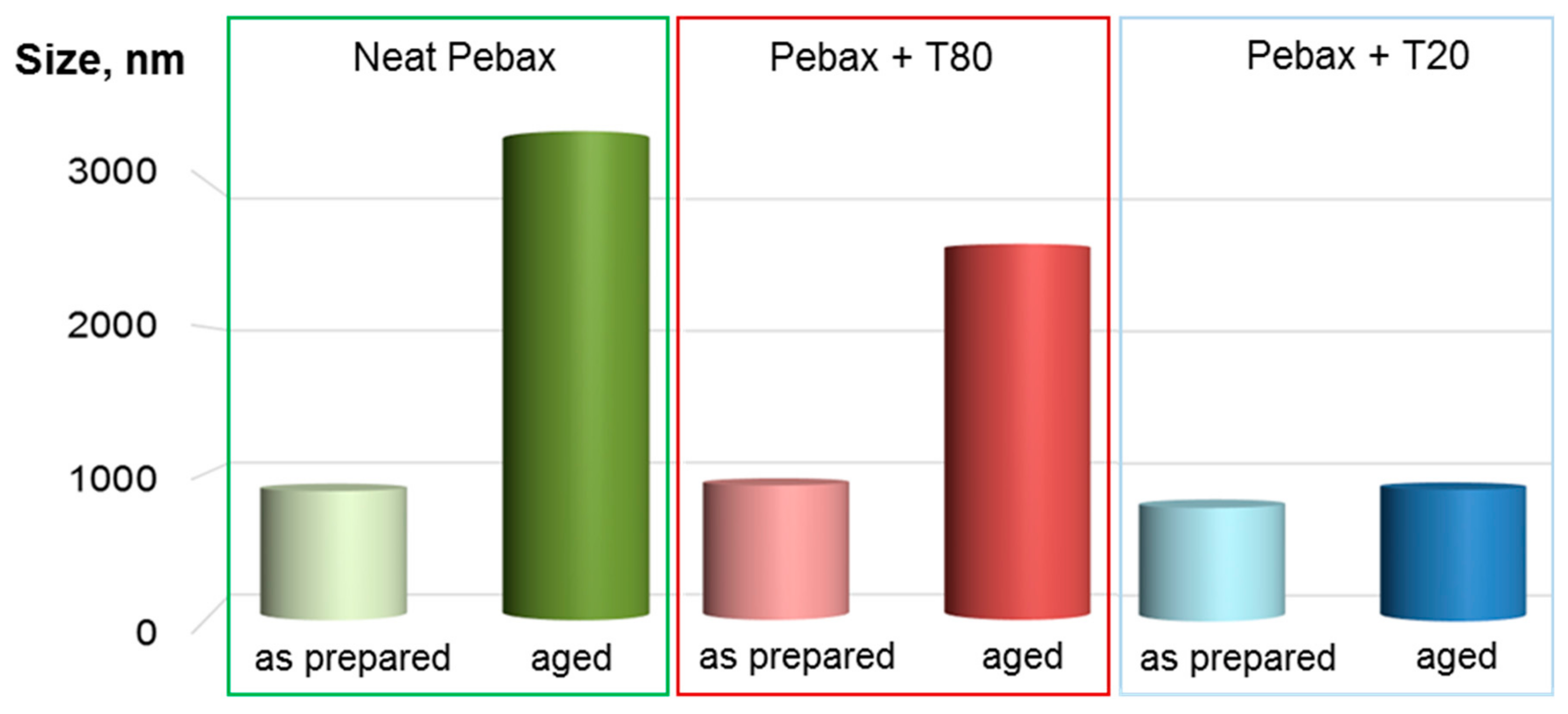

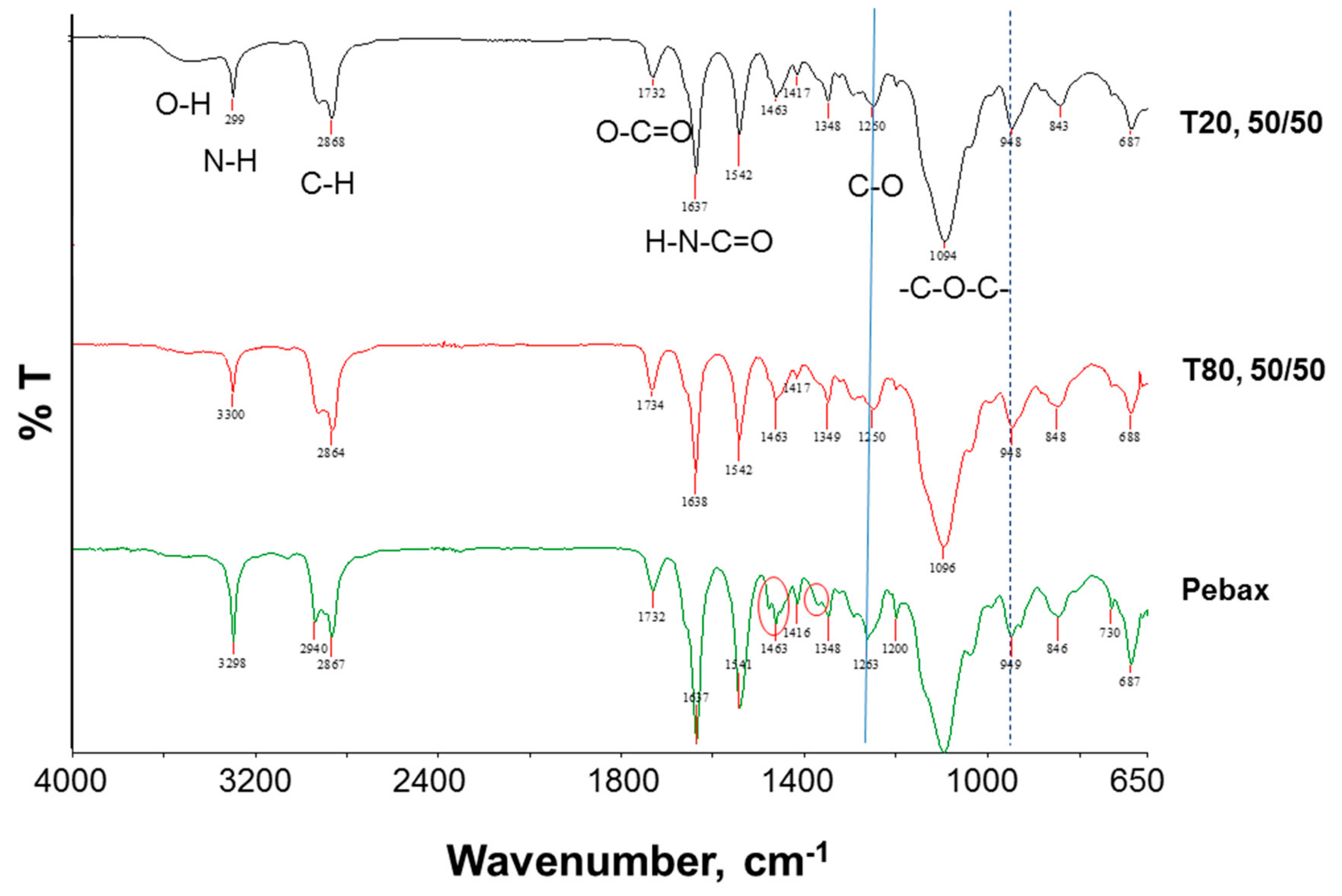
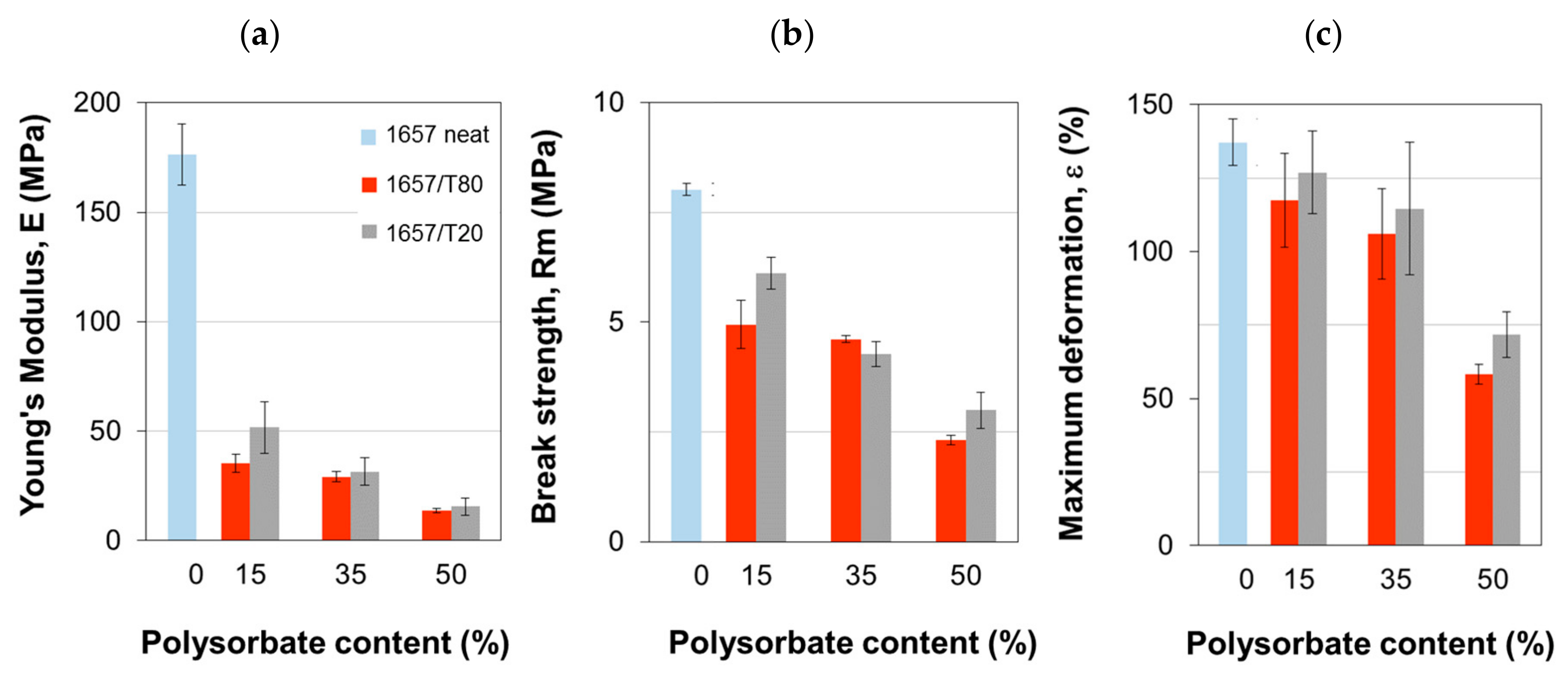
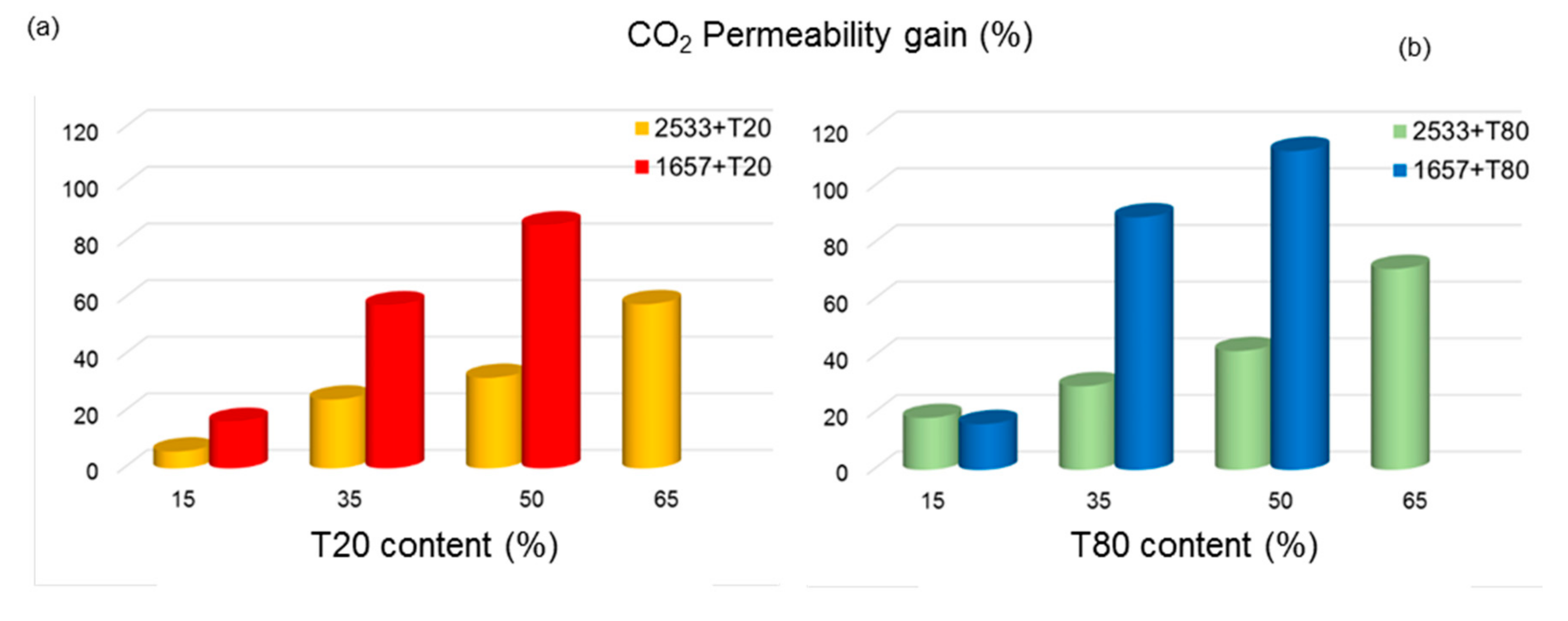
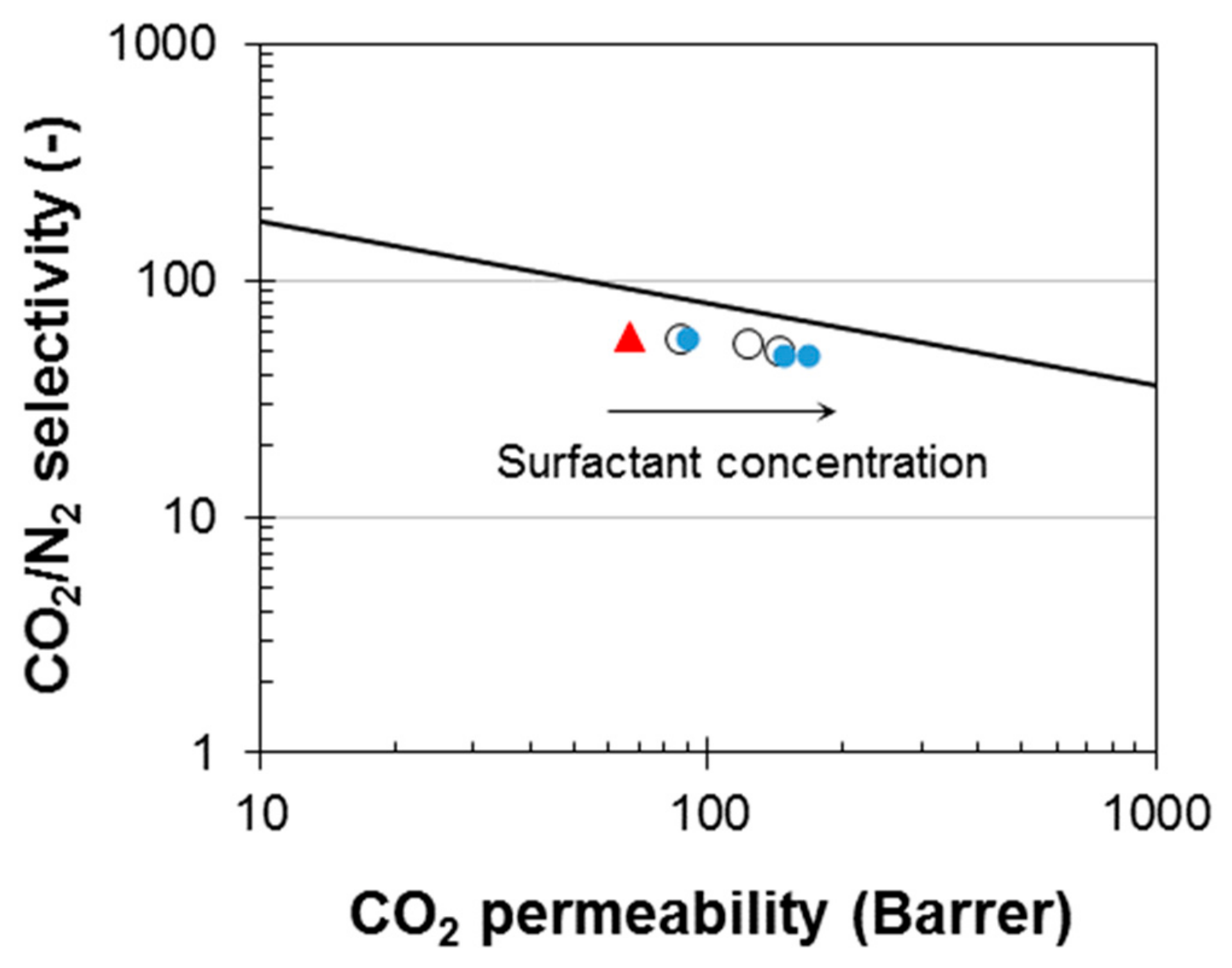
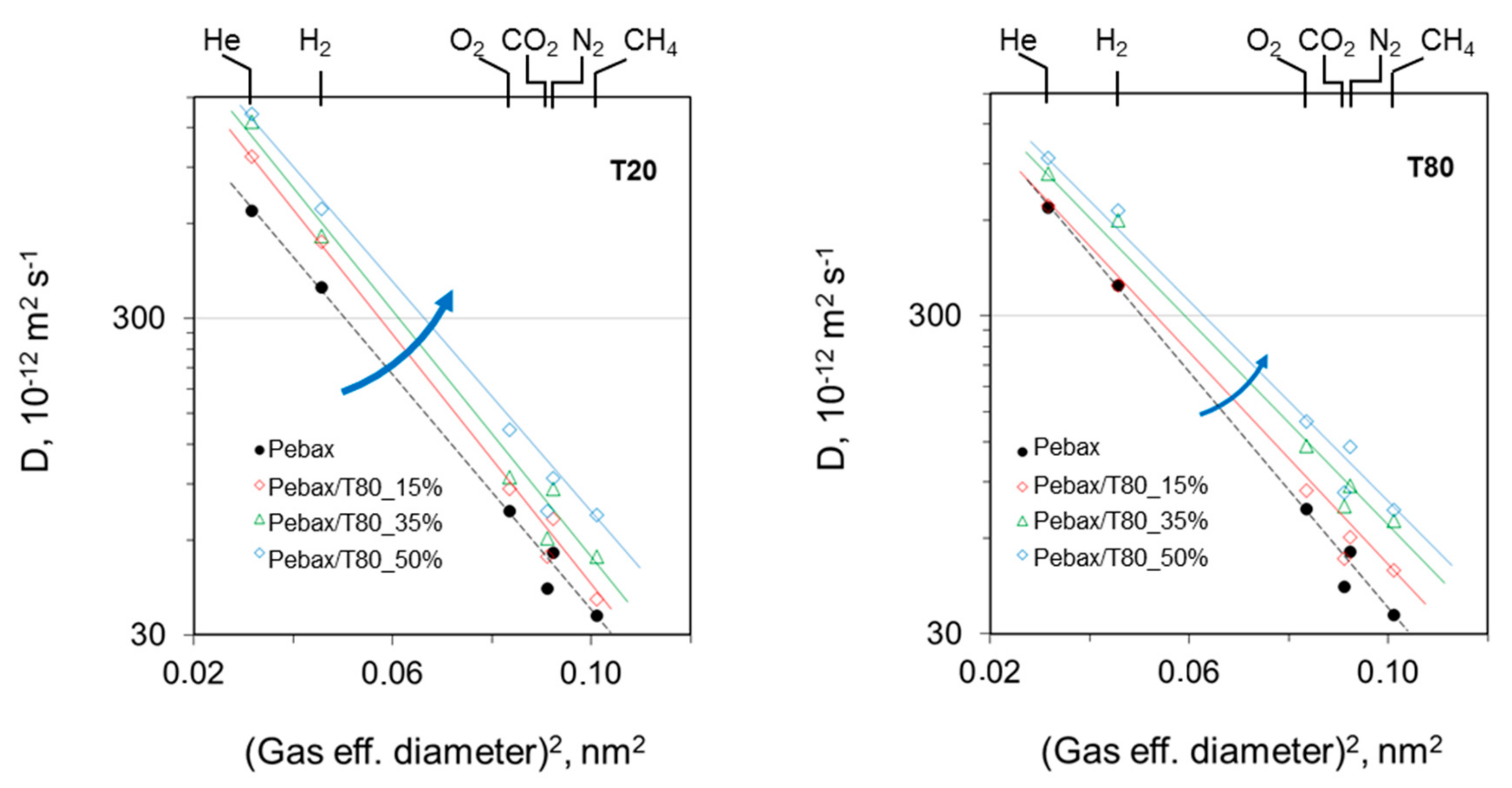
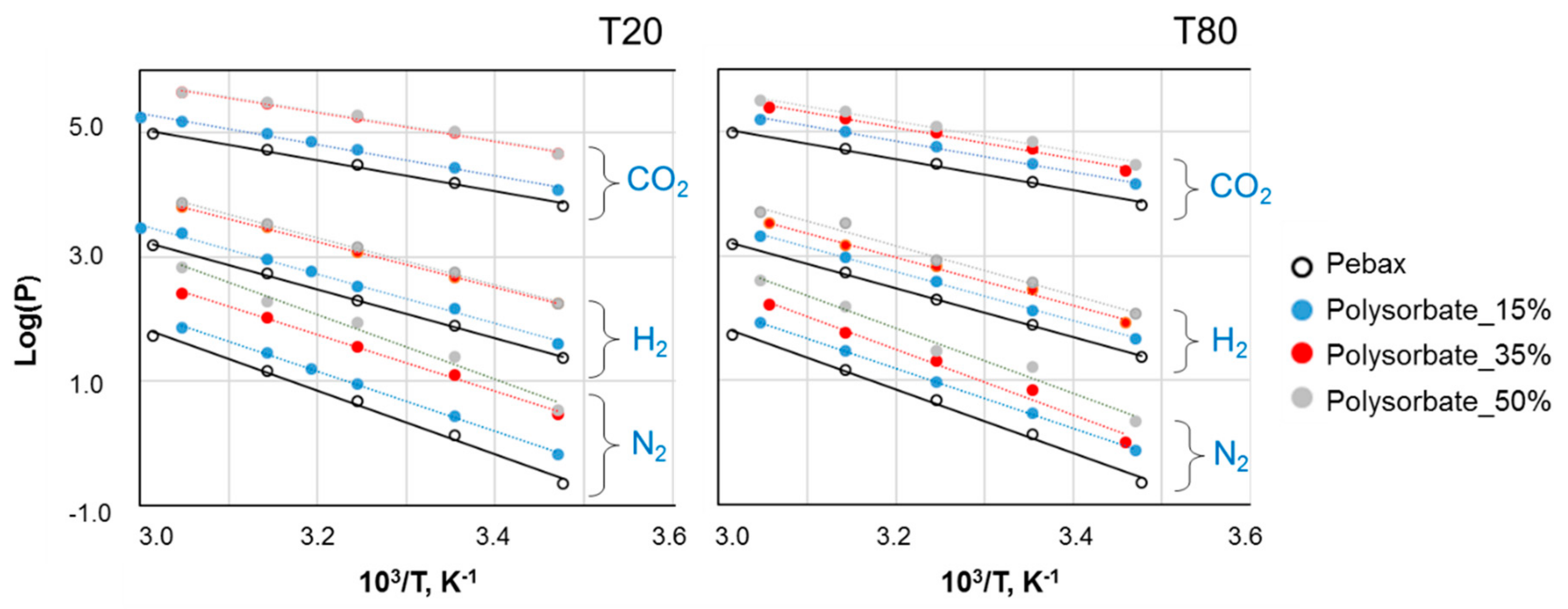
| Surfactant | Molecular Weight (g/mol) | Density (g/mL) | Appearance |
|---|---|---|---|
| PEG20–sorbitan monooleate (T80) | 1310 | 1.064 | Golden-yellow viscous liquid |
| PEG20–sorbitan monolaurate (T20) | 1228 | 1.105 | Clear liquid |
| Solubility Parameter (MPa)0.5 | |||||
|---|---|---|---|---|---|
| Material | δD | δP | δH | δta | Ref. |
| PA6 | 17.0 | 10.6 | 3.4 | 20.3 | [16] |
| PEO | 17.8 | 0.56 | 9.1 | 20.0 | [17] |
| T20 | 19.5 | [18] | |||
| T80 | 19.9 | 5.0 | 6.9 | 21.7 | [19] |
| Ethanol/water mixt. | 15.7 | 11.0 | 26.3 | 32.5 | [20] |
| CO2 | 15.7 | 6.3 | 5.7 | 17.9 | [20] |
| N2 | 11.9 | 0 | 0 | 11.9 | [20] |
| Membrane | Additive (wt %) | Permeability (Barrer) | |||||
|---|---|---|---|---|---|---|---|
| H2 | He | O2 | N2 | CH4 | CO2 | ||
| Neat Pebax | 0 | 6.46 | 3.92 | 2.85 | 1.15 | 3.41 | 66.5 |
| T20 | 15 | 8.28 | 5.21 | 3.92 | 1.55 | 5.50 | 86.7 |
| 35 | 12.2 | 8.50 | 5.67 | 2.27 | 7.71 | 123 | |
| 50 | 16.7 | 10.3 | 8.18 | 2.84 | 10.2 | 144 | |
| T80 | 15 | 8.94 | 6.12 | 4.18 | 1.59 | 5.60 | 90.2 |
| 35 | 14.6 | 9.24 | 7.95 | 3.13 | 10.0 | 149 | |
| 50 | 17.4 | 10.4 | 8.76 | 3.49 | 12.1 | 167 | |
| Pebax/Polysorbate | Ideal Selectivity (−) | |||
|---|---|---|---|---|
| wt/wt | CO2/N2 | H2/N2 | O2/N2 | CO2/H2 |
| Neat Pebax | 57.8 | 5.62 | 2.48 | 10.3 |
| T20 85/15 | 55.9 | 5.34 | 2.53 | 10.5 |
| T20 65/35 | 54.3 | 5.36 | 2.50 | 10.1 |
| T20 50/50 | 50.7 | 5.88 | 2.88 | 8.62 |
| T80 85/15 | 56.7 | 5.62 | 2.63 | 10.1 |
| T80 65/35 | 47.6 | 4.67 | 2.54 | 10.2 |
| T80 50/50 | 47.8 | 4.99 | 2.51 | 9.60 |
| Permeability (Barrer) | Selectivity (−) | |||||||
|---|---|---|---|---|---|---|---|---|
| H2 | He | O2 | N2 | CH4 | CO2 | CO2/N2 | O2/N2 | H2/N2 |
| 16.1 | 9.42 | 8.21 | 3.14 | 11.5 | 151 | 48.1 | 2.61 | 5.12 |
© 2020 by the authors. Licensee MDPI, Basel, Switzerland. This article is an open access article distributed under the terms and conditions of the Creative Commons Attribution (CC BY) license (http://creativecommons.org/licenses/by/4.0/).
Share and Cite
Bernardo, P.; Clarizia, G. Enhancing Gas Permeation Properties of Pebax® 1657 Membranes via Polysorbate Nonionic Surfactants Doping. Polymers 2020, 12, 253. https://doi.org/10.3390/polym12020253
Bernardo P, Clarizia G. Enhancing Gas Permeation Properties of Pebax® 1657 Membranes via Polysorbate Nonionic Surfactants Doping. Polymers. 2020; 12(2):253. https://doi.org/10.3390/polym12020253
Chicago/Turabian StyleBernardo, Paola, and Gabriele Clarizia. 2020. "Enhancing Gas Permeation Properties of Pebax® 1657 Membranes via Polysorbate Nonionic Surfactants Doping" Polymers 12, no. 2: 253. https://doi.org/10.3390/polym12020253
APA StyleBernardo, P., & Clarizia, G. (2020). Enhancing Gas Permeation Properties of Pebax® 1657 Membranes via Polysorbate Nonionic Surfactants Doping. Polymers, 12(2), 253. https://doi.org/10.3390/polym12020253






